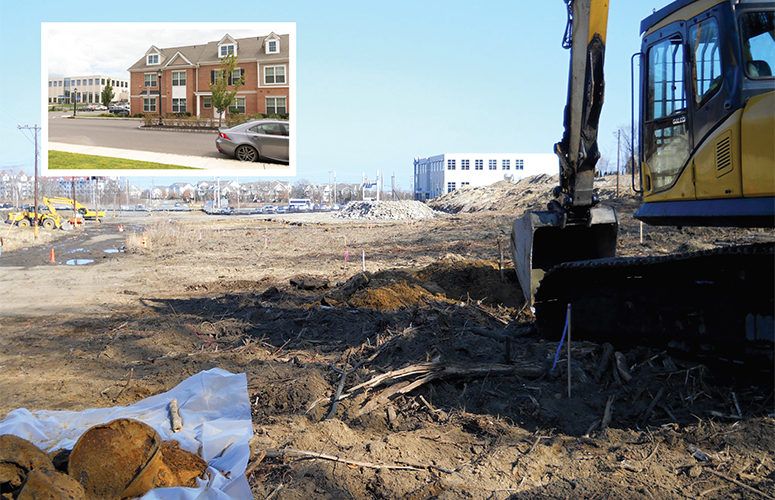
Environmental Engineers ‘Expose the Dirt’ on Site Cleanups
LSRPs and other professionals are producing a greener world, while pushing innovation and technology.
By Josh A. Speert, Contributing Writer On Nov 3, 2020For 50 years, New Jersey has pioneered the environmental protection movement. When Earth Day commenced on April 22, 1970, the New Jersey Department of Environmental Protection (NJDEP) began managing natural resources and solving pollution issues.
This includes implementing the Site Remediation Reform Act (SRRA) of 2009, which revamped and privatized the authority that oversees the remediation of contaminated sites by creating the Licensed Site Remediation Professionals (LSRP) program. LSRPs are specialists accredited by the state to take on inspections of property for environmental issues, with NJDEP oversight.
However, there’s always room for improvement. Living up to its “Garden State” moniker, New Jersey continuously seeks greener site remediation practices, which is why the SRRA was fine-tuned in 2019. A bill known colloquially as “SRRA 2.0” was signed into law, encouraging the use of green technologies and sustainable environmental practices during remediation of a contaminated site whenever possible.
Out With the Brown, in With the Green
The traditional site cleanup method involved driving contaminated dirt to a disposal facility to treat or landfill it. Many remediators are now implementing zero landfill policies as sustainable and more cost-effective options are in demand, according to Charlene Drake, LSRP, PG, an associate at Parsippany-based Langan.
“Our clients are understandably concerned about the environmental toll that comes from remediation technology,” Drake says. “We’re often called in before a property is purchased to determine if the site was contaminated from past uses. We then assess the pollution through testing the soil, groundwater and vapor. An LSRP prepares and sends the report to the NJDEP.”
A prevalent environmental issue in New Jersey, according to Drake, is “historic fill,” which is contaminated soil brought to the site from elsewhere. It commonly has contaminants called “inorganics,” including lead. PAHs (polynuclear aromatic hydrocarbons) are also common in industrial areas when fossil fuels or wood are burned, releasing toxic chemicals into the air and ultimately the soil.
Since removing historic fill requires special attention, Langan collaborates with architectural firms and design teams to level and retain good soil on the site.
“We work together to integrate the design into the site in a way that doesn’t generate excess material or create an exposure,” Drake explains. “For example, if site stormwater has to infiltrate into the ground, you have to ensure that your design doesn’t put that infiltration basin over the contaminated soil.”
Arguably the greatest environmental concerns today are PFAS (per- and polyfluoroalkyl substances), compounds known in the industry as “forever chemicals” due to extremely slow natural breakdown. These toxins have been especially concerning since occupational health studies found detections of some PFAS in the blood of exposed workers as well as the general population. A technology that Langan uses to remove PFAS and other contaminants – including 1,4-dioxane – is the advanced oxidation process (OAP), a pump-and-treat system to remove contaminants found in both drinking water and groundwater.
“Brownfield cleanups and cleanups of industrial properties are probably the highest forms of recycling that you can do,” Drake explains. “It’s rewarding to be integral in a process where we take a crumbling, unsafe warehouse, and turn it into a site that becomes the heart of the community again.”
Langan’s projects already in the pipeline held steady during the COVID-19 pandemic as LSRPs were deemed essential workers by the state.
“New Jersey has a good cleanup program that’s clear and concise, and has an endpoint,” Drake says. “So, when the clients get geared up for these projects, we’re going to continue, even through the pandemic.”
PFAS Awareness Gets Buried
Although the pandemic hasn’t slowed work significantly for many engineering and environmental consulting firms, it has affected PFAS awareness, according to Timothy C. Kinsella, CPG, senior vice president and company environmental practice leader at T&M Associates, Middletown.
“I believe that there would have been a greater public awareness of PFAS in the news, had the pandemic not dominated the headlines,” he explains. “It greatly affects properties and the due diligence stage in general. If PFAS compounds are detected and exceed regulatory criteria in a water system, greater attention is needed. This includes investigation of the source, as well as remedial treatment of the system.
“T&M’s internal PFAS team is currently involved in approximately 15 projects nationwide associated with investigation and/or remediation of PFAS contaminants,” Kinsella says. The company uses several treatment technologies. On most of these projects where water treatment is required, granular activated carbon (GAC) filter beds are utilized, as long as PFAS concentrations, volume and flow are within the acceptable design range. Kinsella mentions that T&M’s number of projects is expected to increase in 2021 as the public becomes more engaged, and the regulations continue to be established by each state, as well as on a federal level through the US Environmental Protection Agency.
Kinsella notes the importance of employing green design practices and technologies regarding the general design issues associated with a property’s end-use. T&M has implemented solar, wind and geothermal technologies in many designs through partnerships with project architects.
“Design criteria and implementation typically reduce the operating cost of a facility, as well as the carbon footprint,” he illustrates. “The architects design with LEED (Leadership in Energy and Environmental Design) points in mind. The more points they can incorporate into a structure, the higher the LEED rating goes, which has many positive effects for the project and owner.
Architects Help Design a Greener Future
When it comes to architecture and environmental engineering, H2M Associates, Inc. is a one-stop shop. The Melville, New York-based company – with New Jersey headquarters in Parsippany – has its own staff of architects, allowing comprehensive project involvement from site assessment right through design and construction.
“Anytime we conduct remediation on a property, we take the end use into account,” says Senior Project Manager Jerry Blustein, LSRP. “We work with our architects or the client’s architects at the start of the job because it helps us establish our remediation goals and develop a strategy that takes site conditions into account. Having engineers and architects stationed 10 feet away from each other makes the process even more efficient.”
Since PFAS are the most critical emergent contaminants being discussed in the industry today, H2M has designed several treatment systems for their removal for large-scale water providers in New Jersey and New York. Customizing the treatment process to include GAC has effectively reduced the presence of these contaminants from public and private water supplies to permissible limits.
“H2M conducted various pilot studies, and when compared with other treatment processes, the use of GAC was identified as the most cost-effective and reliable treatment for PFAS,” Blustein says. “Using the technology developed to treat PFAS contamination for large scale water providers, H2M can readily downsize the treatment process to address source area PFAS contamination at remediation sites.”
As with many companies in the industry, H2M was generally affected by the pandemic, but was able to continue with specific projects as field workers were able to safely maintain a social distance. The only hurdles appeared when certain clients, who temporarily shut down, were not as easily available to discuss projects as they were prior to the pandemic. “We managed through it and came out well. We’re looking forward to an expected uptick in business coming soon,” he says.
The NJDEP working with LSRPs is a win-win situation for New Jersey as well as the environmental engineering industry. “It produces a greener world, while pushing innovation and technology for sampling and analysis,” Blustein explains.
Environmental engineering firms, LSRPs and other key players in the industry can agree that stricter laws yield many benefits for the world and future generations. It can also thankfully indicate job security during uncertain times.
To access more business news, visit NJB News Now.
Related Articles:





